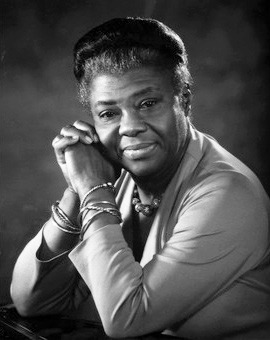Elma Lewis facts for kids
Quick facts for kids
Elma Lewis
|
|
|---|---|
 |
|
| Born |
Elma Ina Lewis
15 September 1921 Boston, Massachusetts, U.S.A.
|
| Died | 1 January 2004 (aged 82) Boston, Massachusetts, U.S.A.
|
| Occupation | Arts educator, Activist |
| Parent(s) | Clairmont Lewis Edwardine Lewis |
Elma Ina Lewis (born September 15, 1921 – died January 1, 2004) was an amazing American arts teacher. She created the National Center of Afro-American Artists and The Elma Lewis School of Fine Arts. She was one of the first people to receive a special award called the MacArthur Fellows Grant in 1981. Later, in 1983, she got a Presidential Medal for the Arts from President Ronald Reagan. She was also an honorary member of the Alpha Kappa Alpha sorority. Elma Lewis helped many young people discover their talents in art and performance.
Contents
Early Life and Education
Elma Lewis was born in Boston on September 15, 1921. Her parents, Clairmont and Edwardine Lewis, had moved to the U.S. from Barbados. Elma had two older brothers, Darnley and George.
When she was very young, at Ruggles Street Nursery School, she was told her IQ was very high. This memory stayed with her. It later inspired her to start her own school. Elma went to Roxbury Memorial High School for Girls. There, she learned about singing, playing piano, and dancing.
She worked in local theater plays to pay for college. She graduated from Emerson College in 1943. Then, she earned another degree from Boston University School of Education in 1944. After college, Elma taught speech therapy at different hospitals. She also taught dance and drama at the Cambridge Community Center. She taught fine arts at the Harriet Tubman House too.
When she was 23, Elma and her parents moved to a new house in Roxbury. She lived there for the rest of her life.
Arts Education and Community
The Elma Lewis School of Fine Arts
In 1950, Elma Lewis started The Elma Lewis School of Fine Arts. Her goal was to offer arts education to the African-American community in Boston. The school had many programs in visual arts and performing arts.
The teachers at the school focused on helping students build good character. They taught many different art forms through performances and exhibitions. Many top artists came to teach there. This made the program very strong. At its busiest time, the school had 700 students and 100 teachers. Many students from the school became successful in entertainment.
The school's fame grew during a time of big changes in Boston. In the 1970s, schools in Boston were ordered to desegregate. This meant bringing students of all races together. However, the school later faced money problems. Enrollment slowly went down. In 1997, after years of financial struggles, the school's building was lost.
National Center of Afro-American Artists
Elma Lewis also founded the National Center of Afro-American Artists (NCAAA). This center brought together her school, local art groups, and a museum. The center found a new home overlooking Franklin Park. It was given to Elma's organization by Jewish leaders. Before this, the school had moved many times, which caused money issues.
By the 1980s, the center owed a lot of money. But one special event kept going strong: the yearly show of Langston Hughes’ Black Nativity. Elma Lewis directed this show herself every year.
Technical Theatre Program
Elma Lewis also created a Technical Theatre Program. This program was for inmates at the Massachusetts Correctional Institute. About 750 inmates at Norfolk Prison joined the program. They put on performances and learned skills like writing music. In 1972, a book called “Black Voices from Norfolk Prison” was published. It shared their experiences, and Elma Lewis wrote the introduction.
Awards and Community Work
Awards and Honors
Elma Lewis was recognized for her amazing work. In 1977, she became a Fellow of the American Academy of Arts and Sciences. She worked hard to promote African American culture through art. She was on the board of many groups, like the Congressional Black Caucus and the NAACP.
She received the Commonwealth Award, which is Massachusetts’ highest award in the arts. She also received almost 30 honorary doctorates from different universities. In 2003, she was named a "Visionary Elder" by the National Visionary Leadership Project. Her work is remembered on the Boston Women's Heritage Trail.
In 1981, Elma Lewis received a "genius grant" from the John D. and Catherine MacArthur Foundation. This was a five-year program that gave money to creative people. In 1983, President Reagan gave her the Presidential Medal for Arts. In 1986, she received the Monarch Award for her lifetime achievements in arts.
Community Involvement
Elma Lewis was known as the "Grande Dame of Arts" in Roxbury. This was because of her school, her achievements in performing arts, and her work in the community. She often traveled to speak at conferences around the world. She shared her experiences running the NCAAA and talked about African-American culture.
In 1980, Elma Lewis was diagnosed with diabetes. But she kept leading cultural programs in Boston. She started the Elma Lewis Playhouse in Franklin Park for summer events. Famous artists like Duke Ellington and Arthur Fiedler performed there. In 2003, the Playhouse was renamed the Elma Lewis Theater at Franklin Park.
In September 1996, Roxbury held a three-day birthday celebration for Elma Lewis. It honored her life and achievements. Famous people like poet Maya Angelou attended. Elma was starting to have serious health problems from diabetes. For her 76th birthday, she collected her papers, photos, and music notes. She gave them to Northeastern University to create a living archive of her work.
Death
Elma Lewis passed away on January 1, 2004. She was 82 years old. She died at her home in Boston from lung problems related to her diabetes.
Images for kids


